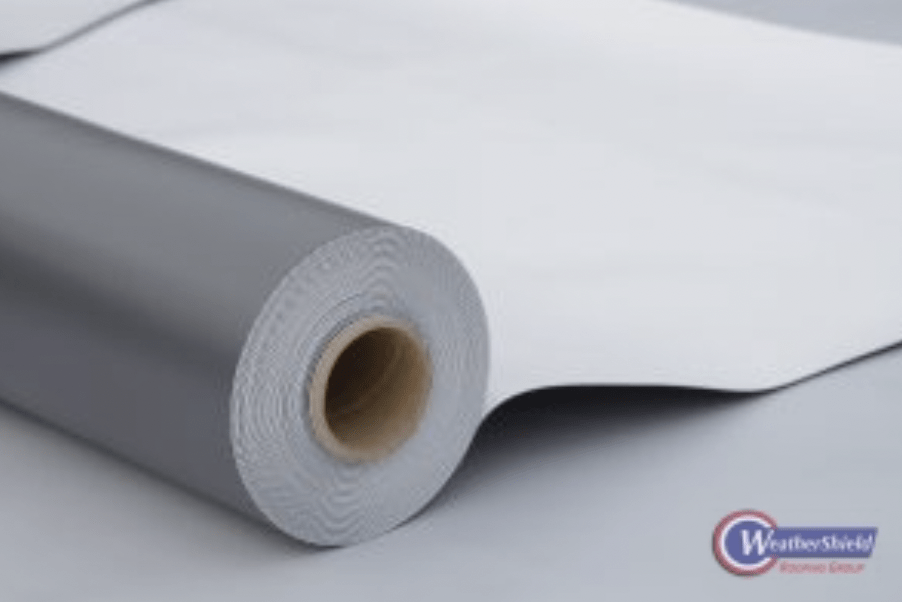What is single ply roofing?
Commercial structures have large roofs, and those large roofs have to be maintained in order to get the longest lifespan possible because replacing them is expensive! So, when a commercial structure owner has to replace the roofing material, there are many choices to make, and single-ply roofing material is a common choice.
Single-ply roofing is wide-width sheeting and is used on flat or low slope roofs. Because it is in wide sheets, there are fewer seams compared to the rolled roofing systems, thus fewer places for roof leaks to occur. It isn’t installed with heat or torches, so less chance of fire, and with the prefabricated detailing accessories of single-ply roofing, installation is easy.
What is single ply membrane made of?
Single ply roofing is created from flexible, strong membranes composed largely of synthetic polymer. The thickness ranges between 1.1mm to over 2mm. Some of the single-ply roofing products are homogenous while others are glass fiber or polyester reinforced with the application it is to be used making the determination which is best.
The membranes are sealed at the joints, forming a continuous waterproof roofing system. With that continuous support combined with insulation, single-ply roofing makes a durable roofing system.
The different membrane types for single ply roofing are:
- CPE – Chlorinated Polyethylene is a flexible single ply roofing material that can be welded by heat or solvent and is compatible with bitumen.
- EPDM – Ethylene Propylene Diene Terpolymer is a flexible material naturally and with carbon black added to it, it becomes more stable. Tape bonding is used for the jointing along with a special primer, and it is compatible with bitumen.
- FPO – Flexible Polyolefin comes from a heat-weldable polyolefin family with a base of polyethylene or polypropylene. It requires a preparation lap prior to being welded in some cases and can be used on a flat roof with aged bitumen.
- PVC – Polyvinyl chloride is a form of flexible PVC with high molecular weight plasticizers that can be welded by heat or solvent. Not suitable for direct bitumen contact.
- TPE – Thermoplastic Polyolefin Elastomer comes from a group of polyolefins with elastomer basic properties and can be treated as thermoplasts. Offers a high UV and ozone resistance that doesn’t absorb moisture and is heat welded without fumes or smoke.
How are single ply roofing membranes secured to a roof deck?
Based on the roof decking, single ply roofing is mechanically attached membrane by augers, concrete screws, nails, or other penetrating fasteners.
How long does single ply roofing last?
When a single ply roofing has been professionally installed properly, and the owner maintains and provides proper upkeep, it can last 30 years or longer.
Why do some single ply roofing materials have a white outer surface?
With single-ply roofing pros and cons, the white outer surface is for UV resistance. Among the pros of single ply roofing are:
The Track Record – For more than sixty years, EPDM single-ply roofing has been around for commercial structures. With a history like that, laboratory and field studies have shown it to be a durable way to roof any commercial structure.
Insulation Material Choices – Single-ply roofing membrane doesn’t include insulation, giving a commercial building owner more choices on how to insulate their structure. Some choices in insulation include:
- Polyisocyanurate – Expensive but the most commonly used because of the high R-value rating.
- Expanded Polystyrene – Dollar for dollar, this has the highest R-value and can be used in the ceiling, walls, or floor.
- Extruded Polystyrene – The colors of blue, green, or pink define this insulation and with a price and performance that is in the middle of the Polyisocyanurate and Expanded Polystyrene.
Reflective or Retentive Properties – With a fast popularity growth, TPO has gained a hold of the commercial single-ply roofing market. The “white roof” is manufactured white for the high reflective ability it offers, but is also available in blue, gray, green, blue, red, and tan. While EPDM is the “black roof” it offers high heat retention, great for colder climates.
Easy Installation – Single ply roofing with TPO offers an easy installation process of spray foam after proper preparation of the existing substrate. It can be attached three different methods:
- Ballasted
- Adhesive
- Mechanically
Comparing EPDM to TPO installation, the EPDM is installed with seam tape and the EPDM is installed with a hot-air gun that melts the membrane seams together.
Flexible, Lightweight – With multiple layers, this single-ply roofing system offers different membrane thicknesses but remains flexible and lightweight, ideal for a structure that doesn’t need extra weight.
Which roof type would a single ply roof membrane be installed on?
Mechanical fastening is ideal for steel or wood when using a single-ply roofing material. Regardless of the slope, there are no limitations, making this an ideal way to roof a commercial structure in a hurricane-prone area.
Do you need ventilation with breathable membrane?
Building regulations today are demanding higher thermal efficiency and with the buildings being enveloped more airtight, ventilation of commercial structures is important. However, ventilation directly above the insulation layer has proven to reduce the thermal efficiency, steering more building owners to choose an un-ventilated roof. With a breather membrane though, it gives the roof the ventilation it needs while providing protection against condensation so that mold is eradicated and less chance of structural damage.
What is the best roofing for a flat roof?
PVC roofing is the preferred choice for most commercial structures for single-ply roofing material. Even at the higher price point, it offers more benefits than other materials. Call (407) 298-0100 today for flat roofing in Longwood and Orlando, FL. Contact us today
